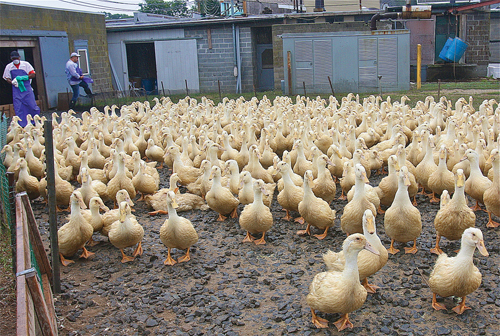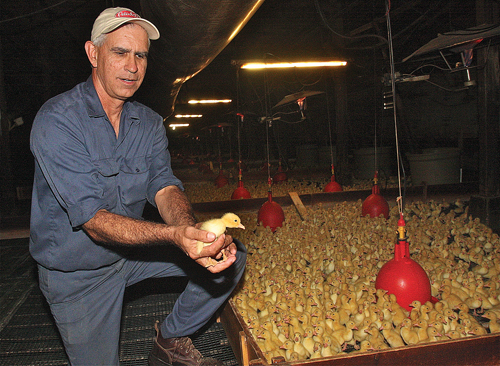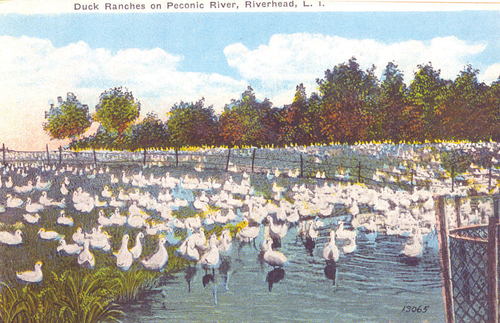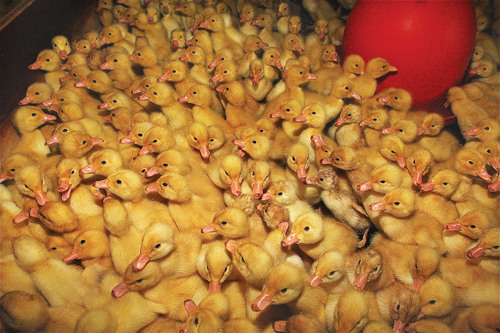And then there was one Long Island duck farm: Crescent

After Chester Massey & Sons duck farm in Eastport closes later this year, there will be just one surviving business in what was once among Long Island’s most prominent agricultural industries.
That fact is not lost on Doug Corwin of Crescent Duck Farm in Aquebogue, which has for years been Long Island’s largest duck farm and will soon be its last.
But even as operating costs continue to escalate and costly state regulations change — a major reason why the Massey family is calling it quits — Mr. Corwin says he’s not going anywhere.
“I see all types of regulatory changes, [from] taxwise to laborwise to food safety,” he said, speaking from the office of the farm his great-grandfather founded in 1908. “Change is the nature of life.”
For that reason, he said it’s long been his family’s business model to budget in a manner that helps them stay ahead of the regulatory curve. Mr. Corwin said he invests in new technologies each year to meet ever-changing standards, most recently spending $3.5 million to update the wastewater treatment facility on the farm.
“I’ve got to think this way,” he said, standing beside a $55,000 piece of equipment that, once installed, will double the farm’s ability to screen out waste solids before treatment.
Mr. Corwin said he’s had success in navigating the standards set by the state Department of Environmental Conservation and is sympathetic to duck farmers who haven’t been able to keep up with regulations.
State DEC officials notified Paul Massey this past winter that operations on his 24-acre Eastport farm, where about 125,000 ducks are still being raised outdoors each year, would need to be moved inside. This would require an addition of hatcheries, or barns, and additional wastewater treatment capability to maintain and clean those structures daily.
For Mr. Massey and his brother Kurt, who have no relatives interested in continuing the family’s 70-year-old farming tradition, the investment was not feasible.
“At one point, for the majority of the people on the East End of Long Island, this was their livelihood. They either lived or worked on the duck farm,” said Mr. Massey. “Now [the perception has] become this smelly farm that is polluting the environment, but that is not the case … I hope [the industry] is remembered for what it did for the heritage of Long Island.”
According to Suffolk County records, Long Island duck farming reached its peak in the 1950s, with more than 90 farms producing 7.5 million ducks annually — about two-thirds of all nationwide production. At that time, the local duck industry was as significant to the New York State economy as the statewide commercial fishing industry.
But state environmental agencies were growing wise to its potential impacts, particularly pollution from effluent runoff entering nearby waters. In fact, by 1948 an earlier version of what’s now known as the Clean Water Act was already beginning to influence the industry. The legislation was aimed at managing pollutants — including animal waste — that discharged into surface waters.
“Was it an environmental situation? It was,” Mr. Corwin said. “[But] we’ve always tried to be proactive.”


Even before the legislation, his family became the first in the industry to work with county engineers to install a wastewater treatment system on the farm, something they had accomplished by World War II.
Regulations began to take their toll on the local industry. By 1963, records show, just 48 farms remained active, with 14, including Crescent Duck Farm, located along Flanders Bay and its tributaries, .
Even more drastic changes occurred in the 1970s, after duck farms were required to install sewage treatment facilities.
“Standards got tighter and tighter as time went on and you either worked, lived and moved forward with the standards, or you perished,” Mr. Corwin said.
“We all had to learn how to become wastewater treatment operators very quickly, or else we didn’t survive,” he said.
Long Island Farm Bureau executive director Joe Gergela estimates that in the past decade only five duck farms have operated on Long Island, as the other slowly shut down, one by one.
Of the final five, Crescent Duck Farm was always the largest, he said.
“No one wants to be the last ranger in town, but they are unique,” Mr. Gergela said. “They have invested many millions throughout the years to stay compliant with the changes regarding environmental protection — and they are pretty self-sufficient.”
The 145-acre farm produces approximately one million ducks annually, which accounts for about 4.5 percent of production nationwide. It is also home to Long Island’s last processing center.
The Aquebogue farm not only raises ducks, but also processes the meat on location and has done processing for Chester Massey & Sons. That farm’s closing translates to a 10 percent loss in Crescent Duck Farm’s processing revenues.
The Corwins harvest and sell every usable part of the bird — from its down feathers, which are sold to the textile and garment industry, to its beak, tongue and feet, which are shipped to select Asian markets. Carcasses are sold to animal feed manufacturers, Mr. Corwin explained.
In 1985, the family also purchased Eastport Feeds, so it could grow its own corn and manage the distribution of feed in an effort to cut down costs.
The duck farm goes through about 230 tons of feed a week, he said.
Mr. Corwin said the loss of Chester Massey & Sons represents more than a cut in revenue for his farm; it marks the end of the camaraderie once shared in the local duck farming industry.
“I am very, very saddened,” Mr. Corwin said. “I went over with my sons and I toured the [Massey] place to see if there was anything we could do to help … what [the DEC wants] them to do, short of a huge chunk of change, it’s not going to happen.”
Mr. Corwin said he hopes his farm can single-handedly sustain the industry and he eventually hopes to pass on the century-old business to his two sons, Blake, 31, and Pierce, 29, who already help run the farm.
“Am I going to die with this being here?” he asked. “I sure hope so.”


